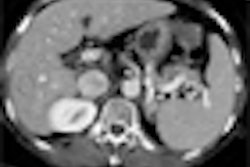Age has a lot to do with the estimated radiation risk of developing cancer as a result of having an abdominal or pelvic CT scan. Senior citizens have half the risk of young adults, a research team told attendees at the American Roentgen Ray Society (ARRS) annual meeting being held in San Diego this week.
A research team led by Dr. James Koonce, a radiology resident from the Medical University of South Carolina in Charleston, conducted a study of 51 patients who underwent routine contrast-enhanced abdominal and pelvic CT scans. The median age for men was 60 years and the median age for women was 48 years. Radiation dose was measured using median CT dose index volume (CTDIvol) and dose-length product (DLP) criteria.
The researchers used an ImPACT CT dose calculator to compute the radiation dose delivered to the six most radiosensitive organs that also receive the highest radiation doses, including the bladder, colon, liver, lung, stomach, and red bone marrow.
Organ doses were adjusted for each patient by accounting for patient weight relative to the 70-kg adult size assumed by the dose calculator. Koonce and colleagues converted the patient organ doses into risks of radiation-induced cancer using data supplied in Biological Effects of Ionizing Radiation (BEIR) VII, taking into account patient age and sex.
The researchers found that the radiation risk for a 31-year-old patient was twice that of a 74-year-old, with younger patients estimated to develop 9.1 cancers per 10,000 imaging exams performed, compared with 4.7 cancers per 10,000 imaging exams for the older individuals, according to Koonce.
With respect to gender difference, the researchers found that the median CTDIvol was 22 mGy for men and 18 mGy for women. They estimated that the carcinogenic radiation risk was approximately 20% higher for women than for men of comparable age, at 7.4 cases per 10,000 studies and 6.1 cases per 10,000 studies, respectively.
Estimating the risks associated with ionizing radiation is complex, Koonce emphasized, but knowing the risk involved with radiation exposure allows for a more accurate risk-benefit evaluation when a physician is considering whether to order an exam.
By Cynthia Keen
AuntMinnie.com staff editor
May 4, 2010
Related Reading
Web site educates patients about radiation dose, July 2, 2009
BEIR VII and separating fact from fear, November 18, 2005
Copyright © 2010 AuntMinnie.com




















